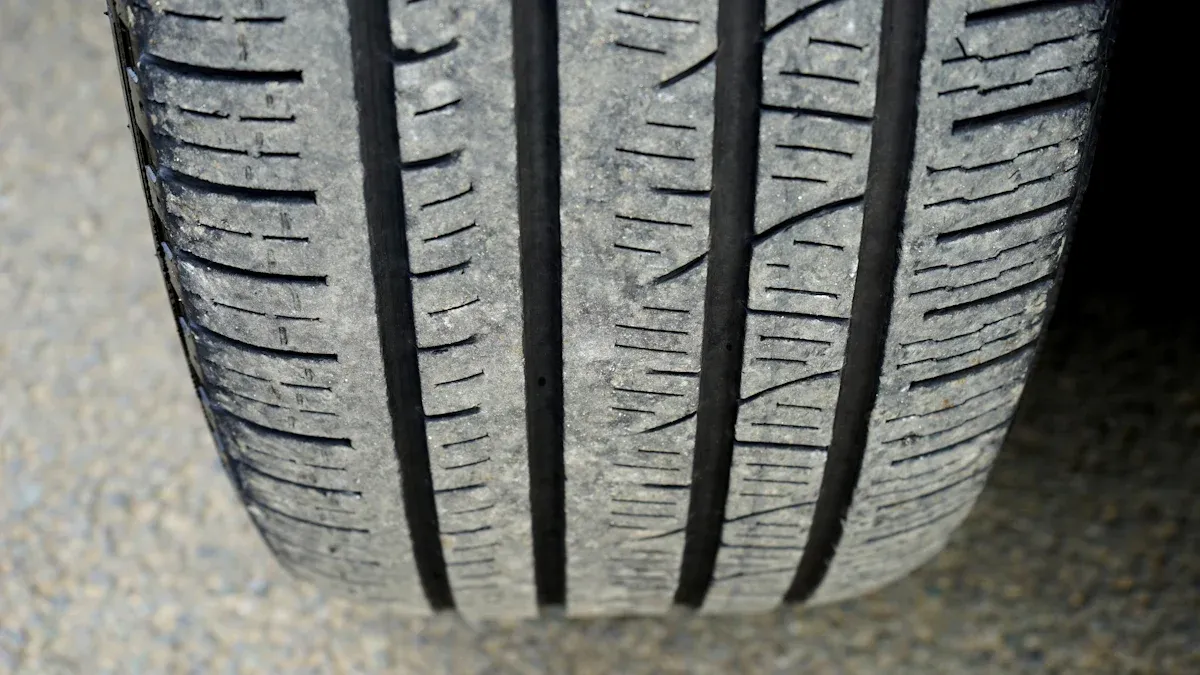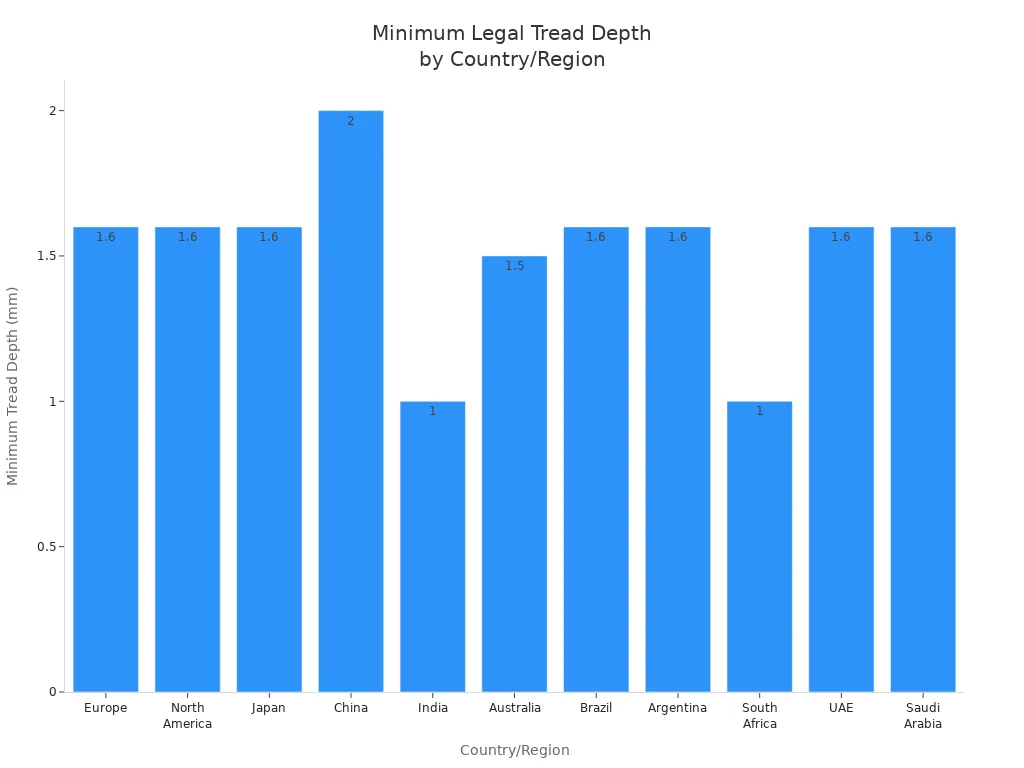
As winter and rainy seasons approach, implementing a Seasonal Spike Strategy by checking your tire tread is crucial for your safety. Ignoring this simple task can lead to significant issues. For instance, old tires can hinder your ability to grip snowy roads, increase stopping distances, and contribute to hydroplaning on wet surfaces. Did you know that only 64% of rideshare drivers frequently check their tires? By being proactive and following a Seasonal Spike Strategy, you not only ensure your safety but also enhance your vehicle’s performance. Don’t wait until it’s too late; prioritize checking your tread today!
Najważniejsze informacje
Check your tire tread depth two times a month. This helps keep you safe on wet and snowy roads.
Use easy methods like the penny test to see if your tires need to be replaced.
Checking your tread often can stop accidents and save you money on gas and repairs.
Get your family involved in tire care. This can make it fun and a good learning experience.
Keeping the right tread depth helps your vehicle work better and lowers the chance of hydroplaning.
TREAD DEPTH BASICS
What is Tread Depth?
Tread depth is the distance from the top of your tire’s tread to the bottom of the grooves. It is very important for how well your tires grip the road. In the U.S., we measure tread depth in 1/32 of an inch. You can check it easily with a miernika głębokości bieżnika opony. This tool gives you a direct measurement. Many drivers do not know about this useful tool, which can lead to poor tire care.
You can also use the penny test for a quick check. Just put a penny into the tread groove with Lincoln’s head facing down. If you see all of Lincoln’s head, it’s time to get new tires!
Importance of Tread Depth
Keeping the right tread depth is important for many reasons:
Przyczepność: Good tread depth helps your tires grip the road, especially when it is wet or snowy. If your tread is too shallow, you might lose control of your vehicle.
Braking Performance: Studies show that lower tread depths mean longer stopping distances. For example, on wet asphalt, worn tires can take up to 50% longer to stop than those with deeper treads. This can make a big difference between a close call and a serious crash.
Ryzyko aquaplaningu: When it rains, tires with low tread depth have trouble moving water away. This increases the chance of hydroplaning. Hydroplaning happens when your tires lose contact with the road because of water, making it hard to steer or stop.
Here’s a quick look at the minimum legal tread depth requirements in different areas:
Region | Minimalna głębokość bieżnika | Additional Notes |
|---|---|---|
Europa | 1,6 mm (2/32 cala) | Standard across EU countries |
Ameryka Północna | 1,6 mm (2/32 cala) | Varies by state in the USA; Canadian provinces may vary |
Asia | Różni się w zależności od kraju | Japan: 1.6 mm; China: 2 mm; India: 1 mm |
Australia | 1,5 mm (0,059 cala) | Uniform across the country |
South America | Różni się w zależności od kraju | Brazil and Argentina: 1.6 mm |
Africa | Różni się w zależności od kraju | South Africa: 1 mm; Others vary |
Middle East | Różni się w zależności od kraju | UAE and Saudi Arabia: 1.6 mm |

CHECKING TREAD DEPTH

Przewodnik krok po kroku
Checking your tire tread depth is simple and can save you from dangerous situations on the road. Here’s a quick guide to help you do it right:
Weź monetę: Take a penny and insert it into the grooves of your tire with Lincoln’s head facing down. If you can see all of Lincoln’s head, your tread is too shallow, and it’s time for new tires.
Use a Quarter for Extra Safety: For added peace of mind, use a quarter instead. If Washington’s head is covered, you have more than 4/32″ of tread left. This is a good threshold for replacing tires.
Look for Tread Wear Indicators: Check for small raised areas in the grooves of your tires. If the tread is level with these indicators, it’s time to replace your tires.
Get a Miernik głębokości bieżnika: For the most accurate measurement, use a tread depth gauge. Extend the probe, place it in the groove, and make sure the measurement is above 1.6mm. Repeat this around the tire’s circumference and across its width.
Remember, tire problems contribute to one out of 11 vehicle crashes. Regular checks can help keep you safe on the road!
Tools for Checking
Having the right tools makes checking your tread depth easier and more accurate. Here are some reliable options:
GODESON Tire Tread Depth Gauge: This digital gauge is known for its accuracy and ease of use.
JACO TreadPro Tire Tread Depth Gauge: An excellent analog option that provides reliable readings.
CZC AUTO Digital Tire Pressure Gauge: A multi-tasking tool that measures both tread depth and tire pressure.
Epkanty Analog, Bar-Style Gauge: A budget-friendly choice that still gets the job done.
100 Pieces Tyre Tread Depth Gauge: Perfect for giveaways or for those who want to keep several on hand.
Using these tools will help you maintain your tires effectively. A digital gauge can provide precise measurements, which is essential for assessing tire tread depth accurately. So, make it a habit to check your tread regularly, especially as the seasons change!
SIGNS OF WORN TREADS
Visual Indicators
You can spot worn treads by looking for specific signs on your tires. Here are some visual indicators to watch for:
Tread Depth Reduction: If you can see the top of Lincoln’s head when using the penny test, your tread is too shallow.
Zużycie na środku: If the center of your tire has shallower treads than the edges, it might be due to overinflation.
Edge Wear: Worn tread on the outer edges, with deeper tracks in the center, often indicates underinflation or misalignment.
Cupping Wear: Look for irregular, scalloped patterns on your tire. This usually points to worn shock absorbers or suspension issues.
Feathering Wear: If the tread blocks feel smooth in one direction but sharp in another, it’s likely a sign of misalignment.
Patchy Wear: Uneven patches across the tire surface can result from severe misalignment or unbalanced tires.
Performance Issues
Worn treads can significantly affect your vehicle’s performance, especially in wet or icy conditions. Here are some common issues you might experience:
Dłuższa droga hamowania: At 60 mph, new tires stop in about 234 feet, while tires with 4/32″ tread need 282 feet. That’s a 20.5% increase in stopping distance!
Increased Hydroplaning Risk: As tread depth decreases, your tires struggle to channel water away, raising the chances of hydroplaning. This can lead to a loss of steering and braking control.
Reduced Cornering Grip: Worn tires can drop your maximum cornering speeds by 10-18% on wet roads compared to new tires. This can make navigating turns much more dangerous.
Keeping an eye out for these signs can help you maintain your safety on the road. Regular checks will ensure your tires perform their best, especially when the weather turns nasty!
BENEFITS OF REGULAR CHECKS

Zwiększone Bezpieczeństwo
Checking your tread regularly makes you much safer on the road. This is especially true in winter and rainy seasons. Keeping the right tread depth is key for how well your vehicle performs in bad weather. Here’s why you should make this a priority:
Better Traction: Good tread depth helps your tires grip the road well. This is very important when driving on wet or icy roads. If your tread is too shallow, you might lose control of your vehicle.
Shorter Stopping Distances: Tires need a tread depth of at least 5/32″ to 6/32″ (~4 – 5 mm) for safe winter driving. Many states say 2/32″ (~1.6 mm) is the legal minimum, but performance drops a lot before reaching this depth. Worn tires can make it take longer to stop, which makes avoiding accidents harder.
Hydroplaning Prevention: Having the right tread depth helps your tires move water away well. This lowers the chance of hydroplaning. Hydroplaning happens when your tires lose contact with the road because of water. Keeping your tread in good shape is an easy way to keep you and your passengers safe.
Remember, regular maintenance and proper tread depth are very important for keeping your vehicle safe. Don’t risk your life or the lives of others on the road!
Zwiększona oszczędność paliwa
Regular tire checks also help you save on fuel. When your tires are in good shape, your vehicle runs smoother. Here’s how:
Aspect of Tire Maintenance | Impact on Fuel Efficiency |
|---|---|
Odpowiednie Napompowanie | Lowers engine workload, saves fuel, boosts mileage |
Tire Alignment | Cuts down resistance, improves handling, raises fuel efficiency |
Rotacja opon | Keeps wear even, maintains traction, boosts gas mileage |
Głębokość bieżnika | Affects grip and fuel use; deeper tread helps efficiency |
Seasonal Care | Adjusts for temperature changes on tire pressure, keeps efficiency |
Tires that are not inflated enough increase rolling resistance. This makes your engine work harder and use more fuel. Checking and keeping tire pressure right can save you a lot on fuel. For example, regular pressure checks can save you up to 3% in fuel costs. Proper alignment and rotation help keep wear even and performance good. Neglecting these can lead to up to 10% more fuel use.
By using a Seasonal Spike Strategy and doing regular tread checks, you boost your safety and improve your vehicle’s fuel efficiency. It’s a win-win!
SEASONAL SPIKE STRATEGY FOR TREAD CHECKS
Implementing a Schedule
To keep your tires in great shape, set up a routine to check them twice a month. Here’s how to do it:
Choose Specific Days: Pick two days each month that work for you. Maybe the first and third Saturday? Write them on your calendar.
Create a Checklist: Use a simple checklist to help with your inspections. Include things like checking tread depth, tire pressure, and looking for any damage.
Set Reminders: Use your phone or a calendar app to remind you of your checks. This way, you won’t forget!
Following these steps can help you stay on track. Car experts say to check your tire tread depth at least once a month. This helps stop blowouts and makes sure your vehicle drives well, especially in bad weather.
Involving Family Members
Getting your family involved in tire care can make it more fun and educational. Here are some tips:
Make It a Family Activity: Turn your tire checks into a family event. Everyone can take turns checking different tires. This teaches responsibility and helps everyone learn about vehicle safety.
Share Responsibilities: Give each family member specific tasks. One person can check tread depth, while another checks tire pressure. This teamwork makes the process faster and easier.
Discuss Seasonal Preparedness: Talk about why these checks are important, especially before winter or rainy seasons. Explain how good tire care can prevent accidents and save fuel.
By involving your family, you create a culture of safety and awareness. Plus, it’s a great way to bond while making sure your vehicle is ready for any weather.
Regular checks are very important, especially in places with lots of rain or snow. Tires should be replaced when they reach a tread depth of 4/32 of an inch. This depth helps you keep a good grip on slippery surfaces. So, make your Seasonal Spike Strategy a family activity, and keep everyone safe on the road!
Checking your tread often is very important for your safety. This is especially true in winter and rainy seasons. If you use a Seasonal Spike Strategy, you can find problems early. This helps you avoid expensive repairs. Here are some good reasons to stay proactive:
Zwiększone Bezpieczeństwo: Keeping your tires in good shape helps stop accidents.
Oszczędności kosztów: Regular checks can save you money on gas and repairs.
Peace of Mind: Knowing your vehicle is safe makes you feel better on the road.
Make tire care a regular habit, and you will have a smoother, safer ride!
FAQ
How often should I check my tire tread?
Powinieneś check your tire tread at least twice a month, especially before winter and rainy seasons. Regular checks help ensure your tires are safe and effective.
What is the minimum tread depth for safe driving?
The minimum tread depth for safe driving is 2/32 inches (1.6 mm). However, for better performance in wet or snowy conditions, aim for at least 4/32 inches (3.2 mm).
Can I replace just one tire?
It’s best to replace tires in pairs, especially on the same axle. This helps maintain balanced handling and traction. If you must replace one, ensure it matches the others in size and tread pattern.
What tools do I need to check my tread depth?
You can use a miernika głębokości bieżnika opony for accurate measurements. Alternatively, a penny or quarter can work for a quick check. Both methods help you assess your tire’s condition easily.
Why is tread depth important in winter?
Tread depth is crucial in winter because it affects traction on snow and ice. Deeper treads channel water and snow away, reducing the risk of hydroplaning and improving your vehicle’s grip on slippery surfaces.
Zobacz także
Znaczenie monitorowania głębokości bieżnika opony dla bezpieczeństwa
Używanie miernika głębokości bieżnika opony do precyzyjnych pomiarów
Zrozumienie detektorów głębokości bieżnika opon inteligentnych i ich funkcji






